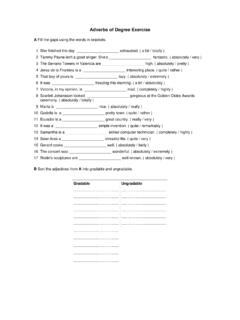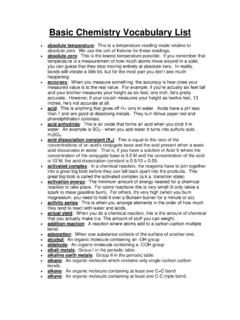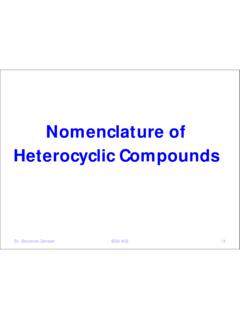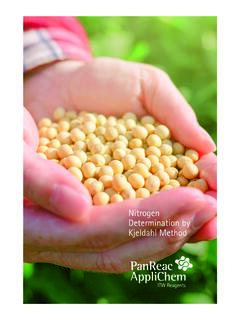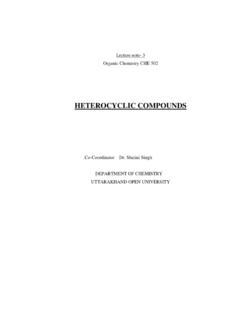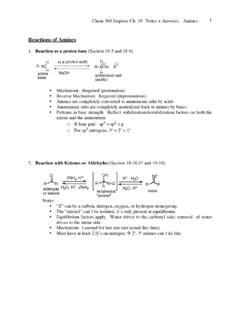Transcription of Petroleum Refining and Petrochemical Processes
1 Petroleum Refining and Petrochemical ProcessesCrude oil: composition, classification; Coal; Oil Shale; Tar Sand; Gas HydratesFaculty of Chemical Engineering and Technology University of ZagrebAnte Juki ZAVOD ZA TEHNOLOGIJU NAFTE I PETROKEMIJUHR-10000 Zagreb, Savska cesta 16, 177 / Tel. +385-1-4597125 / E-adresa: (L. Petroleum , from Greek: (rock) + Latin: oleum (oil))is a naturally occurring flammable liquid consisting of a complex mixture of hydrocarbons of various molecular weights and other liquid organic compounds, that are found in geologic formations beneath the Earth's surface. The name Petroleum covers both naturally occurring unprocessed crude oils and Petroleum products that are made up of refined crude oil. A fossil fuel, it is formed when large quantities of dead organisms, usually zooplankton and algae, are buried underneath sedimentary rock and undergo intense heat and is recovered mostly through oil drilling.
2 This comes after the studies of structural geology (at the reservoir scale), sedimentary basin analysis, reservoir characterization (mainly in terms of porosity and permeable structures).It is refined and separated, most easily by boiling point, into a large number of consumer products, from petrol (or gasoline) and kerosene to asphalt and chemical reagents used to make plastics and is used in manufacturing a wide variety of materials, and it is estimated that the world consumes about 88 million barrels each - Crude oilPumpjack pumping an oil wellProven Oil Reserves [CIA Factbook, 2009] Petroleum - Crude oilCountries with largest oil reserves:Venezuela, Saudi Arabia, Canada, Iran, Iraq, Kuwait, United Arab Emirates, Russia, Kazakhstan, Libya, Nigeria, Qatar, China, United States, Angola, Algeria, BrazilCrude oil ( Petroleum ) is a naturally occurring brown to black flammable liquid.
3 Crude oils are principally found in oil reservoirs associated with sedimentary rocks beneath the earth s surface. Although exactly how crude oils originated is not established, it is generally agreed that crude oils derived from marine animal and plant debris subjected to high temperatures and pressures. It is also suspected that the transformationmay have been catalyzed by rock constituents. Regardless of their origins, all crude oils are mainly constituted of hydrocarbonsmixed with variable amounts of sulfur, nitrogen, and oxygen in the forms of inorganic salts or organometallic compoundsare present in the crude mixture in trace amounts. The ratio of the different constituents in crude oils, however, vary appreciably from one reservoir to , crude oils are not used directly as fuels or as feedstocks for the production of chemicals. This is due to the complex nature of the crude oil mixture and the presence of some impurities that are corrosive or poisonous to processing oils are refined to separate the mixture into simpler fractions that can be used as fuels, lubricants, or as intermediate feedstock to the Petrochemical industries.
4 A general knowledge of this composite mixture is essential for establishing a processing of Crude Oils CompositionThe hydrocarbons in crude oil are mostly alkanes (paraffins), cycloalkanes (naphthenes)and various aromatic hydrocarbonswhile the other organic compounds contain nitrogen, oxygen and sulfur, and trace amounts of metals such as iron, nickel, copper and vanadium. The exact molecular composition varies widely from formation to formation but the proportion of chemical elements vary over fairly narrow limits as follows: Petroleum - Crude oilComposition by weight ElementPercent rangeCarbon83 to 87%Hydrogen 10 to 14% to 2% to to < different types of hydrocarbon molecules appear in crude oil. The relative percentage of each varies from oil to oil, determining the properties of each - Crude oilComposition by weight Hydrocarbon Average RangeParaffins30%15 to 60%Naphthenes49%30 to 60%Aromatics15%3 to 30%Asphaltics6%remainderPetroleum is used mostly, by volume, for producing fuel oiland petrol, both important "primary energy" sources.
5 84 vol. % of the hydrocarbons present in Petroleum is converted into energy-rich fuels ( Petroleum -based fuels), including petrol, diesel, jet, heating, and other fuel oils, and liquefied Petroleum lighter grades of crude oil produce the best yields of these products, but as the world's reserves of light and medium oil are depleted, oil refineries are increasingly having to process heavy oil and bitumen, and use more complex and expensive methods to produce the products required. Because heavier crude oils have too much carbon and not enough hydrogen, these Processes generally involve removing carbon from or adding hydrogen to the molecules, and using fluid catalytic cracking to convert the longer, more complex molecules in the oil to the shorter, simpler ones in the its strictest sense, Petroleum includes only crude oil, but in common usage it includes all liquid, gaseous, and solid hydrocarbons.
6 Under surface pressure and temperature conditions, lighter hydrocarbons methane, ethane, propane and butane occur as gases, while pentane and heavier ones are in the form of liquids or solids. However, in an underground oil reservoir the proportions of gas, liquid, and solid depend on subsurface conditions and on the phase diagram of the Petroleum oil well produces predominantly crude oil, with some natural gas dissolved in it. Because the pressure is lower at the surface than underground, some of the gas will come out of solution and be recovered (or burned) as associated gas or solution gas. A gas well produces predominantly natural gas. However, because the underground temperature and pressure are higher than at the surface, the gas may contain heavier hydrocarbons such as pentane, hexane, and heptane in the gaseous state. At surface conditions these will condense out of the gas to form natural gas condensate, often shortened to condensate.
7 Condensate resembles petrol in appearance and is similar in composition to some volatile light crude proportion of light hydrocarbons in the Petroleum mixture varies greatly among different oil fields, ranging from as much as 97 percent by weight in the lighter oils to as little as 50 percent in the heavier oils and - Crude oilNatural gas flares in the Zubair oil field in southern Iraq / The World Bank: Global gas flaringhas remained largely stable over the past twelve years, in the range of 150 to 170 billion cubic meters. Flaring adds about 400 million tons of carbon dioxide into the atmosphere each crude oil mixture is composed of the following groups:1. Hydrocarbon compounds(compounds made of carbon and hydrogen).2. Non-hydrocarbon Organometallic compounds and inorganic salts (metallic compounds).Hydrocarbon CompoundsThe principal constituents of most crude oils are hydrocarbon hydrocarbon classes are present in the crude mixture, except alkenes and alkynes.
8 This may indicate that crude oils originated under a reducing atmosphere. Composition of Crude Oils Alkanes (Paraffins)Alkanes are saturated hydrocarbons having the general formula CnH2n+2. The simplest alkane, methane (CH4), is the principal constituent of natural , ethane, propane, and butane are gaseous hydrocarbons at ambient temperatures and atmospheric pressure. They are usually found associated with crude oils in a dissolved alkanes (n-alkanes, n-paraffins) are straight-chain hydrocarbons having no branches. Branched alkanes are saturated hydrocarbons with an alkyl substituent or a side branch from the main chain. A branched alkane with the same number of carbons and hydrogens as an n-alkane is called an isomer. For example, butane (C4H10) has two isomers, n-butane and 2-methyl propane (isobutane). As the molecular weight of the hydrocarbon increases, the number of isomers also increases.
9 Pentane (C5C12) has three isomers; hexane (C6H14) has five. The following shows the isomers of hexane:Crude oils contain many short, medium, and long-chain normal and branched paraffins. A naphtha fraction (obtained as a light liquid stream from crude fractionation) with a narrow boiling range may contain a limited but still large number of of Crude Oils C5-C17/ liquids C16 C78/ solids Petroleum is a mixture of a very large number of different hydrocarbons; the most commonly found molecules are alkanes (linear or branched), cycloalkanes, aromatic hydrocarbons, or more complicated chemicals like asphaltenes. Each Petroleum variety has a unique mix of molecules, which define its physical and chemical properties, like color and / PARAFFINSThe alkanes(paraffins), are saturated hydrocarbons with straight (normal) or branched (iso) chainswhich contain only carbon and hydrogenand have the general formula CnH2n+2.
10 They generally have from 5 to 40 carbon atoms per molecule, although trace amounts of shorter or longer molecules may be present in the the alkanes from pentane (C5H12) to octane (C8H18) are refined into petrol, the ones from nonane (C9H20) to hexadecane (C16H34) into diesel fuel, kerosene and jet alkanes with more than 16 carbon atoms can be refined into fuel oiland lubricating oil. - at the heavier end of the range, paraffin wax is an alkane with approximately 25 carbon atoms, while asphalt has 35 and up, although these are usually cracked by modern refineries into more valuable products. - the shortest molecules, those with four or fewer carbon atoms, are in a gaseous state at room temperature. They are the Petroleum gases. Depending on demand and the cost of recovery, these gases are either flared off, sold as liquified Petroleum gas under pressure, or used to power the refinery's own burners.
